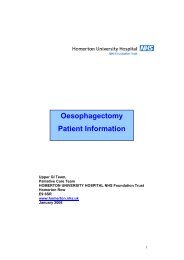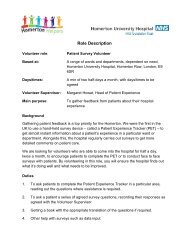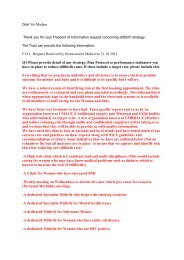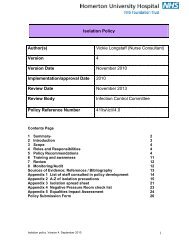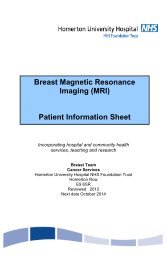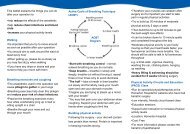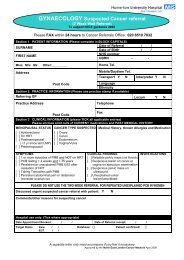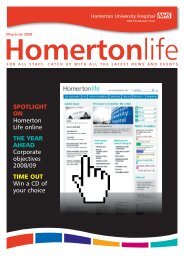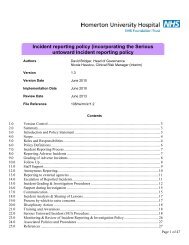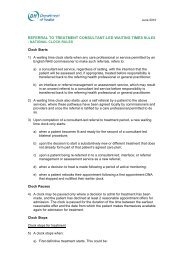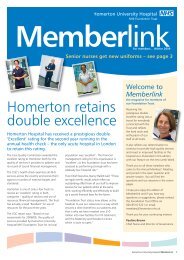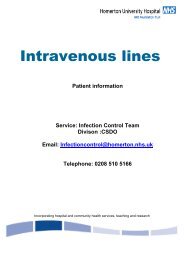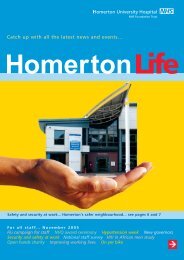What on earth were we thinking of? - Homerton University Hospital
What on earth were we thinking of? - Homerton University Hospital
What on earth were we thinking of? - Homerton University Hospital
- No tags were found...
You also want an ePaper? Increase the reach of your titles
YUMPU automatically turns print PDFs into web optimized ePapers that Google loves.
<str<strong>on</strong>g>What</str<strong>on</strong>g> <strong>on</strong> <strong>earth</strong> <strong><strong>we</strong>re</strong> <strong>we</strong><br />
<strong>thinking</strong> <strong>of</strong><br />
Dr JH Coakley MD FRCP<br />
Medical Director and Intensive Care C<strong>on</strong>sultant<br />
Homert<strong>on</strong> <strong>University</strong> <strong>Hospital</strong> NHS Foundati<strong>on</strong><br />
Trust<br />
Homert<strong>on</strong> Row<br />
L<strong>on</strong>d<strong>on</strong> E9 6SR<br />
john.coakley@homert<strong>on</strong>.nhs.uk
Why<br />
• The philosophers have <strong>on</strong>ly interpreted the<br />
world, in various ways; the point is to change it<br />
Karl Marx<br />
• He who rejects change is the architect <strong>of</strong><br />
decay. The <strong>on</strong>ly human instituti<strong>on</strong> which rejects<br />
progress is the cemetery.<br />
Harold Wils<strong>on</strong>
Homert<strong>on</strong> <strong>University</strong> <strong>Hospital</strong><br />
• Approximately 550 beds (270 medical) in<br />
Hackney<br />
• Emergency care predominates (110,000 A+E,<br />
160,000 OPD, 35,000 IP, 5,000 births)<br />
• Medical take 25 – 40 patients<br />
• Surgical take 8 – 10 patients<br />
• Orthopaedic take – small numbers
Total football…..<br />
Put simply, it means all<br />
10 outfield players in a<br />
team are comfortable in<br />
any positi<strong>on</strong>.<br />
So if a defender wants to<br />
go <strong>on</strong> a mazy run<br />
towards goal, a<br />
midfielder will fill in for<br />
him at the back - and stay<br />
there.<br />
It may sound crazy, but it<br />
was a style <strong>of</strong> play that<br />
made Holland the<br />
greatest side <strong>of</strong> the 1970s.
Is there a simple soluti<strong>on</strong><br />
• Ignore it and hope it will go away<br />
• Expand c<strong>on</strong>sultant grade<br />
• Expand training grades<br />
• Expand some other (doctor) grade
This is not something <strong>we</strong> can avoid,<br />
despite…..<br />
• Pounder R Junior doctors’ working hours: can 56<br />
go into 48 Clin Med 2008: 2; 126-7<br />
• C<strong>on</strong>tinuity <strong>of</strong> care will suffer<br />
• Patient safety will be compromised<br />
• Third way – being <strong>on</strong>-call in hospital<br />
• Horrocks M, Cripps J EWTD 2009 – meeting the<br />
challenge in surgery Ann R Coll Surg Engl<br />
(suppl) 2008; 90: 80-81<br />
81<br />
• ST3+ not required to do full shifts at night
Is there a complicated soluti<strong>on</strong><br />
• Elective emergency split (service and training)<br />
• Recogniti<strong>on</strong> that most emergencies are<br />
“medical”,, even in n<strong>on</strong>-medical patients<br />
• Avoiding increases in doctor numbers for all<br />
tiers <strong>of</strong> all rotas<br />
• Minimise night and <strong>we</strong>ekend working<br />
• Expand ‘normal’ working day
Reality check - EWTD 2009<br />
• C<strong>on</strong>tinuity <strong>of</strong> care by individual juniors is dead<br />
• We therefore have to introduce c<strong>on</strong>tinuity by<br />
system and/or team
Demand for emergency care is rising<br />
A&E Attendances (milli<strong>on</strong>)<br />
A&E Attendances in England<br />
2001-02 to 2005-06 (milli<strong>on</strong>)<br />
20.0<br />
18.0<br />
16.0<br />
14.0<br />
12.0<br />
10.0<br />
8.0<br />
6.0<br />
4.0<br />
2.0<br />
-<br />
14.0<br />
+7.5%<br />
18.8<br />
2001-02 2005-06<br />
Emergency admissi<strong>on</strong>s (milli<strong>on</strong>s)<br />
5.0<br />
4.0<br />
3.0<br />
2.0<br />
1.0<br />
0.0<br />
Emergency admissi<strong>on</strong>s in England<br />
2001-02 to 2005-06 (milli<strong>on</strong>s)<br />
3.9<br />
+4.6%<br />
4.7<br />
2001-02 2005-06<br />
Emergency admissi<strong>on</strong>s (milli<strong>on</strong>s)<br />
35.0<br />
30.0<br />
25.0<br />
20.0<br />
15.0<br />
10.0<br />
Emergency bed days in England<br />
2001-02 to 2005-06 (milli<strong>on</strong>s)<br />
5.0<br />
0.0<br />
31.8<br />
-0.9%<br />
30.7<br />
2001-02 2005-06
Emergency Admissi<strong>on</strong>s: A journey in the<br />
right directi<strong>on</strong> - The Trolley Tsar’s s view<br />
• Sickest patients seen by most junior doctors<br />
• Admissi<strong>on</strong>s scattered through hospital – safari<br />
ward rounds<br />
• Dying throws <strong>of</strong> acute medicine and acute<br />
surgery – emphasis <strong>on</strong> specialties<br />
• Process and care have improved in last 5-105<br />
years - but more acti<strong>on</strong> still required
The Emergency Department:<br />
Medicine & Surgery Interface Problems &<br />
Soluti<strong>on</strong>s, RCS (Eng) 2004<br />
Key Recommendati<strong>on</strong>s<br />
• Early senior-led decisi<strong>on</strong>s<br />
• Assessment units<br />
• On-take team with no other commitments<br />
• Committed acute physicians based <strong>on</strong> AU
NCEPOD 2005 - Findings<br />
Time bet<strong>we</strong>en gross physiological instability and subsequent referral to ICU<br />
n=162, 66% had clearly identifiable gross physiological abnormalities > 12 hours<br />
prior to referral to ICU.
NCEPOD - patients who died<br />
• Training must be provided for junior doctors<br />
in the recogniti<strong>on</strong> <strong>of</strong> critical illness and the<br />
immediate management <strong>of</strong> fluid and oxygen<br />
therapy in these patients.<br />
• C<strong>on</strong>sultants must supervise junior doctors<br />
more closely and should actively support<br />
juniors in the management <strong>of</strong> patients rather<br />
than <strong>on</strong>ly reacting to requests for help.<br />
• Junior doctors must seek advice more readily.<br />
This may be from specialised teams e.g. outreach<br />
services or from the supervising c<strong>on</strong>sultant.
NICE – July 2007<br />
Educati<strong>on</strong> and training should be provided<br />
and staff should be assessed to ensure that they<br />
can dem<strong>on</strong>strate competence.
NCEPOD 2007<br />
• Delays in seeing a doctor <strong>of</strong> adequate seniority may<br />
have a detrimental effect <strong>on</strong> patient care<br />
• more important for patients to be seen by a c<strong>on</strong>sultant within a reas<strong>on</strong>able<br />
time frame determined by clinical c<strong>on</strong>diti<strong>on</strong> rather than by a c<strong>on</strong>sultant <strong>of</strong><br />
appropriate specialty<br />
• can result in delayed definitive care and poor outcome<br />
• Lack <strong>of</strong>, or poor, decisi<strong>on</strong> making by training grade<br />
doctors<br />
• Ability <strong>of</strong> trainees to recognise critically ill patients<br />
is poor – simple physiology though
NCEPOD 2007<br />
• Robust handover systems need to be put into<br />
place bet<strong>we</strong>en clinical teams<br />
• These should be readily identifiable and<br />
protocol based<br />
• Clinicians should be made aware <strong>of</strong> protocols<br />
and mechanisms
Acute medicine - making it work for<br />
patients (RCP 2007)<br />
• 5 We recommend that a c<strong>on</strong>tributi<strong>on</strong> to the<br />
practice <strong>of</strong> acute medicine from appropriately<br />
trained c<strong>on</strong>sultants in emergency (A&E)<br />
medicine and critical care should be facilitated.<br />
• 6 We recommend that appointments in acute<br />
medicine should be developed that include<br />
commitments to accident & emergency (A&E)<br />
departments, high-dependency units and<br />
intensive care units, as <strong>we</strong>ll as AMUs.
<str<strong>on</strong>g>What</str<strong>on</strong>g>’s s it all about<br />
• We have got it wr<strong>on</strong>g<br />
• We must do better<br />
• It’s s a system problem<br />
• Therefore the system must change<br />
• How
<str<strong>on</strong>g>What</str<strong>on</strong>g>’s s it all about<br />
• We have created Procrustean silos<br />
• Patients d<strong>on</strong>’t t come to hospital because they are<br />
orthopaedic, or surgical or medical (or anything<br />
else)<br />
• They come because they are sick and they think<br />
<strong>we</strong> can help<br />
• Emergency admissi<strong>on</strong>s are more predictable<br />
than elective
<str<strong>on</strong>g>What</str<strong>on</strong>g>’s s the visi<strong>on</strong> for emergency care<br />
• 98% in 4 hours – basic minimum acceptable standard<br />
• Emergency care delivered across boundaries by<br />
specialists who are interested and committed<br />
• Set up ‘cold team’ and ‘hot team’ for training and service<br />
delivery<br />
• Over time (say five years) integrati<strong>on</strong> <strong>of</strong> acute,<br />
emergency and critical care medicine to provide a<br />
seamless service<br />
• Improve training while complying with EWTD 2009<br />
• Extend c<strong>on</strong>sultants’ “normal” working day -
Taking Care 24/7 – how <strong>we</strong> ran it<br />
• First formal meeting <strong>on</strong> 1st November 06<br />
• Regular, fortnightly Project Board meetings<br />
since January 07
Taking Care 24/7 – how <strong>we</strong> ran it<br />
• Project Board – meetings every 2 <strong>we</strong>eks<br />
• Medical Director<br />
• Operati<strong>on</strong>s Director<br />
• Clinical Director <strong>of</strong> Medicine<br />
• Director <strong>of</strong> PGME<br />
• Associate director <strong>of</strong> HR<br />
• Junior doctor representative<br />
• Senior nursing representative<br />
• Project manager<br />
• Representative <strong>of</strong> the Nati<strong>on</strong>al Workforce<br />
Projects
Acute Care Unit<br />
• 56 beds<br />
• Planning based <strong>on</strong> 48 hour LOS<br />
• Receives all acute admissi<strong>on</strong>s in surgery,<br />
orthopaedics, urology and medicine<br />
• Junior staffing proporti<strong>on</strong>ate to emergency<br />
activity<br />
• Busy!
Acute Care Team<br />
• C<strong>on</strong>sultants (12P, 6S, 5T+O, 5 ICM, 3U)<br />
• 6 Medical ST 3+ or SpRs (AM or EM)<br />
• 8 Medical ST 1 or 2, FY2 (ACCS or AM)<br />
• 3 Surgical ST 2 to 6<br />
• 1 Orthopaedic ST 2 to 6 (0800 - 2200 <strong>on</strong>ly)<br />
• 1 ICM ST 1 to 6 (0800 – 1600 <strong>on</strong>ly)<br />
• 6 Foundati<strong>on</strong> Trainees – FY1<br />
• CCO<br />
• CSM
Acute Care Team (ACT)<br />
• C<strong>on</strong>sultant led 24/7 team with no commitments<br />
other than acute care bet<strong>we</strong>en 0800 and 2000<br />
• Extended normal working hours for acute care<br />
(including c<strong>on</strong>sultants) and improved handovers<br />
• C<strong>on</strong>sider which clinicians are best able to deliver<br />
the required competencies<br />
• Integrate delivery <strong>of</strong> acute care across specialties<br />
• Develop sustainable acute rotas
Weekday and night ACT
Weekend ACT
Taking Care 24/7 - blockers<br />
• Dislike <strong>of</strong> change<br />
• Risk aversi<strong>on</strong><br />
• MMC<br />
• EWTD<br />
• Custom and practice<br />
• ‘the college says….’<br />
• ‘the dean says….’<br />
• ‘my boss says….’<br />
• ‘I’m m not covered to….’
Taking Care 24/7 - enablers<br />
• Dislike <strong>of</strong> change<br />
• Risk aversi<strong>on</strong><br />
• MMC<br />
• EWTD<br />
• Custom and practice<br />
• ‘the college says….’<br />
• ‘the dean says….’<br />
• ‘my boss says….’<br />
• ‘I’m m not covered to….’
Taking Care 24/7 - enablers<br />
• Medical Council, GEM Board, Clinical<br />
Board, Postgraduate meetings….<br />
• Reference Groups for both medical and<br />
nursing staff<br />
• Discussi<strong>on</strong> documents e-mailed e<br />
to<br />
interested parties<br />
• E-mail discussi<strong>on</strong> encouraged<br />
• Homert<strong>on</strong> Life; CE’s s Brief etc<br />
• Lots <strong>of</strong> corridor and canteen c<strong>on</strong>versati<strong>on</strong>s
Taking Care 24/7 - enablers<br />
• Draft papers <strong>on</strong> operating policy covering:<br />
• Rotas<br />
• Formal plans<br />
• New structures and processes/procedures<br />
• Open fora<br />
• Differences <strong>of</strong> opini<strong>on</strong><br />
• Robust discussi<strong>on</strong> about the philosophy <strong>of</strong><br />
provisi<strong>on</strong> <strong>of</strong> care for emergency/acutely un<strong>we</strong>ll<br />
inpatients
<str<strong>on</strong>g>What</str<strong>on</strong>g> works <strong>we</strong>ll<br />
• Doctors’ hours<br />
• Relati<strong>on</strong>ships bet<strong>we</strong>en medics, surge<strong>on</strong>s, critical<br />
care and outreach have improved<br />
• Night handover is very good (but H@N)<br />
• Patients seen by a c<strong>on</strong>sultant very quickly<br />
• Emergency / elective split works <strong>we</strong>ll for ‘cold<br />
team’ juniors<br />
• The change in surgical and orthopaedic rotas (for<br />
the ED).
Example – most FY2 - ST2<br />
• 16 <strong>we</strong>eks per year acute work<br />
• Full shift for acute work<br />
• Protected training time in “cold” specialty for<br />
rest <strong>of</strong> year – no nights; no <strong>we</strong>ekends
Example – most ST3+<br />
• 12 <strong>we</strong>eks per year acute work<br />
• Full shift for acute work<br />
• Protected training time in “cold” specialty for<br />
rest <strong>of</strong> year – no nights; no <strong>we</strong>ekends
<str<strong>on</strong>g>What</str<strong>on</strong>g> is the impact <strong>on</strong> training<br />
• On 1:12 SpR rota they got 130 <strong>we</strong>ekdays every 6<br />
m<strong>on</strong>ths <strong>of</strong> which 15 <strong><strong>we</strong>re</strong> ‘<strong>on</strong>-call’ which meant<br />
two days (total 30) <strong>of</strong>f ie 100 days <strong>of</strong> cold<br />
training.<br />
• Now 4.5 m<strong>on</strong>ths or 95 <strong>we</strong>ekdays <strong>of</strong> cold training<br />
• Not much different from before even given the<br />
reducti<strong>on</strong> <strong>of</strong> hours from 56 to 48.<br />
• Better supervised during their hot spell.<br />
• Either way, the overall effect for a medical SpR<br />
is pretty negligible.
ACT – mortality for n<strong>on</strong>-elective<br />
admissi<strong>on</strong>s
Mortality rate<br />
Like for like comparis<strong>on</strong><br />
Mean<br />
Standard<br />
Deviati<strong>on</strong><br />
31 st July 06 to 6 th November 06<br />
3.4%<br />
1.1%<br />
30 th July 07 to 5 th November 07<br />
2.8%<br />
1.1%
Admissi<strong>on</strong>s per <strong>we</strong>ek<br />
Like for like comparis<strong>on</strong><br />
Mean<br />
Standard<br />
Deviati<strong>on</strong><br />
31 st July 06 to 30 th October 06<br />
229<br />
15.1<br />
30 th July 07 to 29 th October 07<br />
249<br />
28.0
Rate <strong>of</strong> 28 day readmissi<strong>on</strong>s<br />
Like for like comparis<strong>on</strong><br />
Mean<br />
Standard<br />
Deviati<strong>on</strong><br />
31 st July 06 to 30 th October 06<br />
9.0%<br />
2.4%<br />
30 th July 07 to 29 th October 07<br />
10.6%<br />
2.9%
Surprises<br />
• Pressure in system largely related to elective<br />
activity <strong>we</strong>ll over plan<br />
• Emergency admissi<strong>on</strong>s numbers largely as<br />
predicted<br />
• Increase in night and <strong>we</strong>ekend emergency<br />
admissi<strong>on</strong>s<br />
• Major problem is “outflow” from “cold” areas<br />
• Majority <strong>of</strong> c<strong>on</strong>sultants enthusiastic about<br />
principles and helpful in their criticism
Hard to change, easy to stay the same,<br />
but……<br />
• D<strong>on</strong>'t be so gloomy. After all it's not that awful.<br />
Like the fella says, in Italy for 30 years under the<br />
Borgias they had warfare, terror, murder, and<br />
bloodshed, but they produced Michelangelo,<br />
Le<strong>on</strong>ardo da Vinci, and the Renaissance. In<br />
Switzerland they had brotherly love - they had<br />
500 years <strong>of</strong> democracy and peace, and what did<br />
that produce The cuckoo clock. So l<strong>on</strong>g Holly.<br />
Ors<strong>on</strong> Wells (Third Man)



